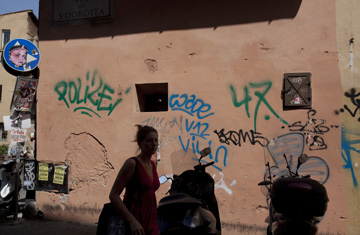
Writing a wrong Most public surfaces in Rome, like this wall on Via del Moro, are blighted by graffiti
On a blustery October day in the northern part of Rome, a group of nearly 100 volunteers spreads out along a leafy street and sets to cleaning. Pedestrian barriers are scraped free of rust and repainted in their original yellow. Old leaflets are peeled off walls. And graffiti, the group's main target, is either scrubbed away or painted over. "This street is the Wild West," says Paola Carra, who's overseeing the operation. "We need to maintain it ourselves. We can't wait for somebody else to do it."
Many modern cities have trouble with vandalism, but Rome seems to be a case apart. Outside of the touristic center, it's a rare public surface that hasn't been plastered with leaflets or covered with graffiti: tags, slogans, declarations of love, outbursts against authority. And there are few signs that much is being done about it. In some areas, it's possible to come across scribbled celebrations of soccer championships from before the turn of the century. "Inside [people's homes], everything is perfectly clean," says pharmacist Maria Vitale, 47, as she heads out to the cleanup. "Outside, everything is dirty. There's trash on the ground. People don't clean up after their dogs." The problem, says Carra, 46, is the absence of personal responsibility. "We've lost our sense of community," she says.
Carra's volunteers are part of an effort called Retake Rome that was sparked last year by American lawyer Rebecca Spitzmiller. Frustrated by the graffiti defacing her apartment building, Spitzmiller set out with her teenage son to clean it herself. Her dedication struck a chord, and soon she was joined by others in organizing cleanups of the city's parks, streets and monuments. Run by a dozen volunteers, Retake Rome uses a website and newsletter to coordinate gatherings once or twice a month. In spring last year, three U.S. ambassadors and Rome's mayor helped scrub graffiti off a 15th century footbridge over the Tiber River. "If everybody just cleaned their own building, it would be done in a week," says Spitzmiller, 54.
To the Italians involved in the project, it's no surprise that it was an American who got it started. "There's no history of collaboration between [Italian] society and the public administration," says Francesco Garibaldi-Hibbert, the great-great-grandson of Giuseppe Garibaldi, the 19th century revolutionary who helped unite the country. The result, says Gianfranco Pasquino, professor of political science at the University of Bologna, is a disconnect between the country's public spaces and those who use them. "If there is a problem, it is not our business," he says of the average Italian's attitude. "It is the mayor's. He has the power, and he should do it." (While the city of Rome has an antigraffiti squad, it's all they can do to keep the monuments of the historic center clean.) With a few exceptions, Retake Rome has caught on faster with the city's international community than with its locals, so the effort has now turned to getting more Italians involved.
Keeping Rome clean is an uphill battle. The country has a long history of vandalism — the word graffiti was coined in the 1850s to describe messages scratched into the walls of ancient Pompeii. And there's only so much a small group of expatriates and committed Italians can do. Indeed, when the group cleaned up the historic bridge last year, it was hit once again only four days later. "We were 100 people against one," says Lori Hickey, 52, one of the project's co-founders and a manager at a fine-arts moving company. "It was ruined by just one person who [wrote] his initials 40 times."
By this measure, the autumn outing is a success. A group of 60 Italian students from a nearby secondary school tackles the cleanup of a small park. A handful of boys wrestle a buried stump from the ground, while others rake up candy wrappers, cigarette butts and cellophane wrappers. By lunchtime, the students have painted over the graffiti on the park's wooden benches and planted climbing vines along its wire fence. "In the end, Rome is ours," says Francesca Baldaro, 16. "If nobody else will do it, we have to set an example."
